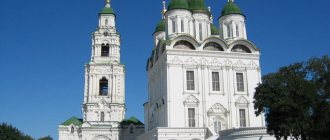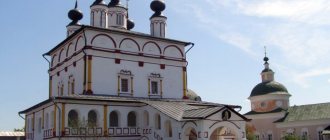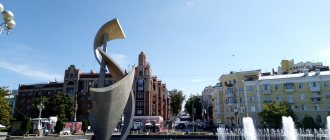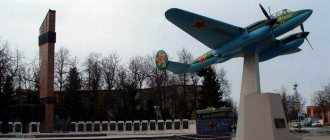Samara is a beautiful, modern city located on the Volga River. At all times of the year it attracts tourists from all over the world. Perhaps there are not many historical attractions, religious and natural monuments, but the city has enough objects that will tell the history of Russia in the 19th-20th centuries.
The longest embankment, green parks, alleys, dozens of museums with unique, rich exhibitions - these are not all the features of Samara. The diverse architectural appearance of the city, which harmoniously combines traditional classics, socialist constructivism, and modern modernism, is attractive.
History of Samara
“Samara Town” - a settlement with this name was founded on the banks of the Volga in 1586. The order to build the city was issued by Fyodor I the Blessed, who wanted to control the territories through which major trade routes passed. The first memories of the town date back to the 14th century. It is named Samar on the map of merchants from Venice.
Fortress "Samara City"
At first, mostly soldiers lived here. Trade is developing in the city, buildings with defensive walls are being built. In 1688, the city received the status of a district and at the same time the name Samara, which has survived to this day. The number of residents reached several thousand. In 1780, government institutions began to be founded here: courts, treasuries, councils. The development plan for the city territory was approved only in 1782.
Samara in the 19th century
In 1850 Samara became the center of the province. Population: 15,000. This figure increases to 90,000 in just 50 years. Bazaars and large fairs are held here, where residents of neighboring settlements come to sell agricultural products, household items, gold and silver items, and textiles. In 1877, a railway was built through Samara, and the local marina received up to 1000 ships a year. Trade is developing rapidly, the city is being actively built up with merchant palaces and estates, some of which have been preserved in good condition.
Samara in the twentieth century and today
The years 1917-1918 were marked by the establishment of Soviet power here. Since 1935, Samara has been called Kuibyshev. After the collapse of the USSR, the historical name returned. During the Second World War, aircraft manufacturing was actively developing in the city, famous military aircraft and attack aircraft were being assembled. Soon enterprises specializing in the development and creation of rockets appeared. The aerospace industry made a major contribution to the formation of the city's economy.
Today Samara is an important economic, cultural, scientific center in which industry is actively developing. In addition, it is an interesting tourist city with an abundance of modern and historical sites.
Dynamics by year
Dynamics of the permanent population of Samara over the past 5 years:
- 2015 – 1,171,820 people
- 2016 – 1,170,910 people
- 2017 – 1,169,719 people.
- 2018 – 1,163,399 people.
- 2019 – 1,156,608 people.
- 2020 – 1,156,659 people.
From 2015-2020, the number of residents decreased by 15,161 people. However, at the beginning of 2022, a slight positive growth trend in the number of residents began to be observed.
Sights of Samara
There are few historical monuments, but this will not prevent you from having an interesting and exciting time. Visit the gallery, which displays paintings by famous artists. You can walk through museums with unique exhibitions and ancient collections, or stroll along Leningradskaya Street, along the city embankment.
Samara embankment and beach
This is the most popular place among city residents and a must-see for tourists. The length of the equipped embankment is 5 km. It was reconstructed just a few years ago: fountains were installed, new benches for relaxation, a path for cyclists was laid out, and interesting sculptures were installed. You can walk along the embankment endlessly; it is beautiful here, especially on a spring or summer evening.
Zhigulevsky plant
The Zhigulevsky plant is a real pearl for lovers of intoxicating drinks. This is where the famous Zhigulevskoye beer is made. The plant itself is located in a house that is an important architectural monument. Tourists are given a fascinating excursion and are also offered to try a foamy drink. In the store at the factory you can buy several bottles of beer for yourself or as a gift.
Stalin's bunker
Joseph Stalin was very prudent, so he carefully prepared in case of nuclear war. Shelters were established in different cities of the USSR. They were built in dugouts at a depth of several meters. The Samara bunker was declassified only in 1990. The object lies under the building of the Academy of Culture and Arts. The building is not afraid of any external influences and provides the highest degree of protection against bombing. Today excursions are organized here.
"Russia is my history"
An interesting modern facility will open in 2022. The construction of this park was timed to coincide with the World Cup. Of course, you won’t be surprised by archaeological finds and historical exhibits here, but a pleasant experience from visiting the park is guaranteed. Using multimedia technologies, the history of Russia is demonstrated on large interactive screens. Tourists are offered to listen to stories about one or another historical period, watch films and videos, and get acquainted with unique collections of valuable exhibits, although they are presented only in electronic form.
Iversky Convent in Samara
The monastery was created no more than 150 years ago. The monastery still operates today, being considered the oldest in Samara, and is a unique architectural complex that consists of religious shrines, residential buildings, and utility buildings. Pilgrims from all over the world often come here. From afar you are attracted by the sparkling gilded domes of the temples. Several years ago the buildings were restored. The monastery houses the relics of St. Alexander Chagrinsky. There are workshops and a library at the monastery. You can freely walk around the territory of the Iversky Convent, but the cells of the monks are not available for inspection.
Samara Space Museum
Since the Second World War, Samara has served as a rocket science center. Launch vehicles, components for missiles, and ballistic missiles are developed at the local factories. The Vostok model was released in Samara, on which Yuri Gagarin flew into space. The Samara Space Museum is a huge complex consisting of 3 floors. The main exhibition is located on the 1st floor, and additional collections are located on the 2nd and 3rd floors. The institution is open from Tuesday to Friday according to the schedule from 10.00 to 18.00. Saturday and Sunday are shortened working days.
Kurlina's mansion
Kurlina's mansion is a beautiful historical building with Art Nouveau features. This is an important part of the urban landscape of Samara. The estate was described by A. Tolstoy in his novel “Walking Through Torment.” The house was built by order of the wealthy Kurlins. They spared no expense and invested considerable funds in the development of the city’s culture and infrastructure. Today, in the building of the mansion there is a Museum of Art Nouveau, which presents unique exhibitions that testify to the development and formation of the Art Nouveau movement. 100-year-old interiors surprise with their originality and unusualness. They have been perfectly preserved to this day.
The mansion attracts attention at first sight. The façade of the building is lined with spectacular blue tiles, which enchant with their elegant gloss. The overall composition is complemented by a white base and green inserts. Stucco was used as decoration. The pediment is decorated with a sculpture of a woman's head, the windows are decorated with plant stems, and the cornices are decorated with forging in the form of dragonflies and butterflies. On the 1st floor, the typical interior of merchant housing of the 20th century has been preserved. The interior space is divided into a large hall, a dining room, a boudoir, and a study. A separate exhibition consists of expensive household items: elegant accessories, festive and everyday outfits, paintings, dishes and cutlery, luxurious furniture. On the stands accompanying the collection there is an informative explanation with a brief historical background.
Wonderland Park "Galileo"
Galileo is a find for visitors of all ages. Here are the most interesting physical phenomena presented in a fun, accessible way. Among the exhibits, special attention is drawn to:
- a labyrinth with mirrors;
- an upside down room;
- magic balls and other similar attributes;
- a talking head without a body;
- infinite cube, etc.
The total number of exhibits exceeds 50. A guide or consultant will help you understand them; they are in every room. The park also has its own laboratory, where visitors are invited to participate in experiments.
Roman Catholic Church of the Sacred Heart of Jesus
A luxurious, austere religious landmark with tall spiers and severe forms, built in 1906. The implementation of the Moscow architect's project took 4 years. Today this building is known as the Polish Church. The temple was not destined to exist for long. As soon as Soviet power settled on the territory of Samara, the shrine was closed. Valuable historical monuments stored here were confiscated and sold in the 30s of the twentieth century. The temple turned into a deserted place, where over time a children's theater was located, then a cinema and drama school, later a construction club, then an anti-religious museum.
Only in 1991, after the collapse of the USSR, the functionality of the shrine was resumed. And after another 5 years, a major restoration is carried out and the temple is reconstructed. Today it attracts not only believers, but also tourists, because it is an important architectural and religious landmark of the city. You can examine its unique facades from the outside, go inside and admire the original interiors. The Divine Liturgy is regularly served here and concerts of classical and sacred music are organized.
Strukovsky Garden
The oldest and most majestic park in the city of Samara. Guests and locals love to relax here. Clean air, alluring nature, well-developed infrastructure - this is what attracts Strukovsky Garden. For vacationers there are comfortable benches, for cyclists there are equipped paths, for connoisseurs of natural aesthetics there are beautiful fountains and waterfalls. In the center there is a statue of a wild goat, which is considered the symbol of this region. By the way, members of the chess club often organize competitions here. You can just come and play mind games.
House with elephants
You can't pass by the house with the elephants. He's very unusual. The modern building effectively complements the city’s landscape and gives it a special charm. The mansion was built in 1909. Well-known architects of that time worked on the development of design documentation: P. Golovkin, V. Tepfer. Golovkin was also the customer; he was a merchant, was a patron of many cultural objects, and painted pictures. The architecture of the building combines features of Art Nouveau and the Viennese Secession, which is quite unusual for a provincial Russian town of the early twentieth century.
Singing fountains of Samara
Spring and summer evenings in Samara are something exciting and memorable. Take a stroll by the CSKA VVS pool. Amazing singing fountains attract attention here. With their help, light and sound shows are organized. Water jets form atypical shapes that swirl, shimmer, play in different colors, and all this is accompanied by pleasant music. The musical compositions are chosen very well, they play modern compositions and classics (Mozart, Vivaldi, etc.). If you get closer to the fountain, you can get under the refreshing stream. This place is considered one of the most romantic in Samara; couples in love love to stroll here. The embankment near the singing fountains is always fun and crowded, there are performances and street musicians playing.
Samara has something to surprise you with. The city is developing rapidly, characterized by a well-developed tourist infrastructure and an abundance of modern attractions. In Samara you can have a pleasant time at the zoo, indoor water park, cat cafe, and entertainment centers. There are also many restaurants, hotels, and cafes that happily welcome tourists from different regions of the country.
Area and Density
The region is located in the southeastern part of the Russian Federation. The region is located in the middle reaches of the Volga River. The total area of Samara is 541.4 sq. km. There are a large number of monuments, squares, and parks for families with children. The beautiful city on the Volga is divided into nine administrative districts:
- Industrial: the number of residents of the district in 2022 is 272,498 people.
- Kirovsky - 224,889.
- Sovetsky district – 169,015.
- Oktyabrsky district – 119,451.
- Zheleznodorozhny – 90 530.
- Krasnoglinsky – 99 713.
- Kuibyshevsky - 88,876.
- Leninsky district - 61,276.
- Samara district – 30,411.
The largest part of the population is concentrated in the Industrial District. It is not surprising, because this is where the main educational institutions and the bulk of industrial enterprises are located. The population density of Samara for 2022 is 2136.16 people/km².
Reproduction rates
Reproduction indicators for 2022 in Samara have negative dynamics. There were 3,437 fewer children born in 2022 than in 2022. Since 2000, the city has seen a steady decline in the number of deaths. Death rates in 2022 have decreased by approximately 1,000 cases.
The alarming situation with the birth rate has been observed for many years. These conclusions can be drawn by examining the population's birth rate indicators years earlier:
| Year | Children born |
| 1970 | 42190 |
| 1975 | 47507 |
| 1980 | 46468 |
| 1985 | 49508 |
| 1990 | 39918 |
| 1995 | 28409 |
| 2000 | 25791 |
The sad trend is associated with the constant reduction of women of fertile age. The state plans to stimulate the birth rate of Samara women with a cash payment that can be received after the birth of the first child.
Flag
The flag of Samara is made in the form of a rectangular panel. Its aspect ratio is 1:2 (de facto 2:3 is used). It consists of three equal horizontal stripes: red (top), white (middle) and blue (bottom). On the bottom there is the inscription “Samara”. The city's coat of arms is depicted in the center. The distance from it to the top edge of the flag is 1/7 of the width of the flag. The heights of the capital letter and the crown are equal, the lowercase letters are 1/10 of the width of the composition.
The flag was approved on December 30, 1998 (as amended on October 14, 2014).











